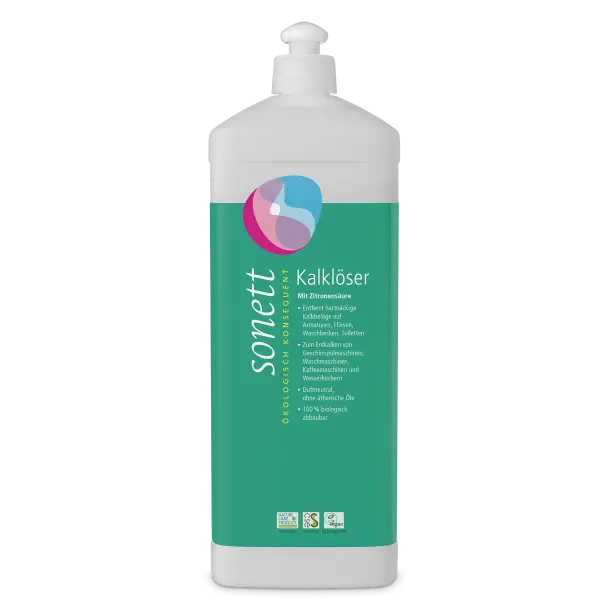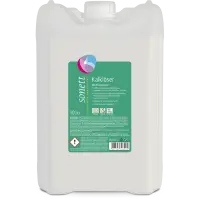
- Sonett odorless limescale remover,
- for descaling dishwashers, washing machines, coffee machines and kettles,
- removes stubborn limescale deposits on taps, tiles, sinks, toilets,
- odorless, without essential oils,
- 100% biodegradable
Product feature Sonett Limescale Remover 1 Liter
The odorless Sonett Limescale Remover uses citric acid because of its gentle effect on metals and plastics and its quality as a food ingredient. The Sonett Limescale Remover is perfect for removing stubborn limescale deposits in the kitchen and bathroom area.
Application area Sonett Limescale Remover 1 Liter
Wherever stronger calcifications occur, the Sonett Limescale Remover can be effectively used. For example, on taps, tiles, toilets, pots, electric cookers, coffee machines, washing machines and much more.
Attention
Citric acid is descaling. Please keep away from calcareous surfaces such as marble, concrete, artificial stone, limestone, etc.
Application Sonett Limescale Remover undiluted
You can use the Sonett Limescale Remover undiluted on taps, toilets or tiles. Undiluted use where the Sonett Limescale Remover cannot be heated. Depending on the layer of limescale, simply let it work for a few minutes and then rinse thoroughly with clear water.
Application Sonett Limescale Remover diluted
Dilute the Sonett Limescale Remover when the Sonett Limescale Remover is heated e.g. for descaling machines like kettles, coffee machines or in pots.
Dosage for descaling the kettle
Add approx. 100 ml Sonett Limescale Remover per 0.5 liter of water and heat the whole to approx. 60 °C. Let it work for approx. 20 to 30 minutes and rinse well afterwards.
Dosage for descaling the coffee machine
Add 200 ml Sonett Limescale Remover and 800 ml water to the coffee machine's water reservoir. Please follow the instructions for use of the respective machine you are descaling. A subsequent run with clear water is absolutely necessary - until the water is clear.
Dosage for descaling a 4.5 kg washing machine
Add 1 liter of Sonett Limescale Remover to the 60 °C main wash (without laundry). Let the wash cycle run and also clean the lint filter.
Dosage for descaling the dishwasher
Add 1 liter of Sonett Limescale Remover to the main wash cycle of the longest rinse cycle (after pre-rinsing!) - without or with dishes. Let the program run until the end.
Size: 1 Liter
Product declaration Sonett Limescale Remover 1 Liter
Citric Acid 15-30%, Vegetable Alcohol (Ethanol) 5-15%, Water, Swirled to 100%
Ingredient list according to EC 648/2004 Sonett Limescale Remover 1 Liter
Aqua, Citric Acid, Alcohol
Attention
Contains food grade citric acid. Can still cause serious eye irritation. Always keep packaging or label if medical advice is needed. Keep out of reach of children. Wear eye protection. In case of contact with eyes: Rinse cautiously with water for several minutes. Remove contact lenses, if present and easy to do. Continue rinsing. If eye irritation persists: Get medical advice. Dispose of contents/container in accordance with local/national regulations.
Origin and properties of the ingredients
By-products of the sugar industry such as molasses are the raw material for the production of citric acid. During the descaling process, the citric acid acts in its general property as an acid on the precipitated limestone and dissolves it again with the development of carbon dioxide.
Keep out of reach of children.
Eco-Certification
NCP (Nature Care Product), CSE (Certified Sustainable Economics), Vegan Society
EAN: 4007547303003 Manufacturer: Sonett GmbH Mistelweg 1, 88693 Deggenhausen [email protected]Bewertung eines Trusted-Shops-Nutzers
Schonende Kalklösung
Bewertung eines Trusted-Shops-Nutzers
Bewertung eines Trusted-Shops-Nutzers
Kundenbewertung schreiben
Bewertung eines Trusted-Shops-Nutzers
Schonende Kalklösung
Bewertung eines Trusted-Shops-Nutzers
Bewertung eines Trusted-Shops-Nutzers
Ausrufezeichen

Akute Toxizität (oral, dermal, inhalativ), Kategorie 4 Reizwirkung auf die Haut, Kategorie 2 Schwere Augenreizung, Kategorie 2 Sensibilisierung der Haut, Kategorien 1, 1A und 1B Spezifische Zielorgan-Toxizität (einmalige Exposition), Kategorie 3 Atemwegsreizung, Kategorie 3 Narkotisierende Wirkung Die Ozonschicht schädigend, Kategorie 1



